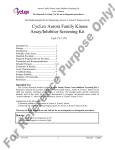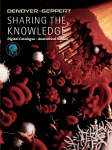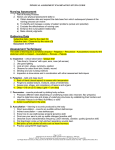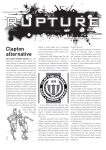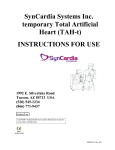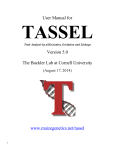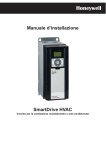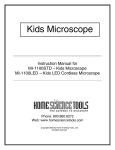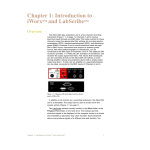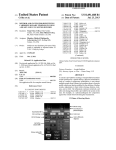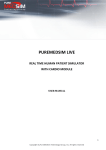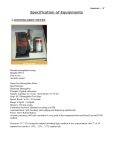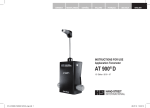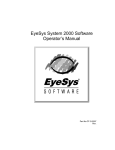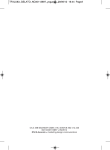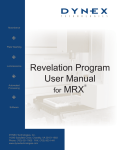Download Bio11 Lab Manual W11
Transcript
De Anza College Biology 11 Laboratory Manual Human Biology Winter 2011 Instructor: Ann Reisenauer 2 Biology 11 Laboratory Manual Human Biology Contents Lab 1 Microscopy . . . . . . . . . . . . . . . . . . . . 5 Lab 2 Macromolecules . . . . . . . . . . . . . . . . 17 Lab 3 Cells and Mitosis . . . . . . . . . . . . . . . . 23 Lab 4 Enzymes . . . . . . . . . . . . . . . . . . . . . 27 Lab 5 Circulation and Respiration . . . . . . . . . .35 Lab 6 Diet Analysis: Are You Eating Right? . . . 43 Lab 7 Urinary System . . . . . . . . . . . . . . . . . 53 Lab 8 The Senses . . . . . . . . . . . . . . . . . . . . 59 Lab 9 Genetics . . . . . . . . . . . . . . . . . . . . . . 65 3 4 Lab 1: Introd uction to M icroscopy With the invention of the microscope, scientists were able to resolve much smaller objects and see the cells and parts of cells that make up living things. The fields of science, medicine and technology have all advanced greatly with knowledge gained from using microscopes. This exercise is intended to get you familiar with our microscopes and the ways to use them so you can see things you cannot see with your eyes alone. Parts of the light microscope Each student has an assigned microscope for his or her own use. The microscopes are numbered, and you should get the one that matches the number of the seat you are sitting in. (Be sure to return it to the proper numbered slot when you are done.) Carry the microscope to your seat with both hands (you don’t want to pay for a broken microscope!). Plug the cord into the socket in front of your table and push the button on the microscope base to turn the light on (turn the light off when not in use). Label the following parts of the microscope on the figure above. 5 Eyepiece or ocular lens • where you can look into the microscope. • magnifies objects ten times (10X). • Some microscopes are monocular (one eyepiece) and some are binocular (two eyepieces). Does your microscope have one or two eyepieces? Objective lenses • Longer objectives have higher magnifying power. • Scanning objective, magnifies 4 times (marked 4X). • Low-power objective, magnifies 10 times (marked 10X). • High-power objective (marked 40X). • Oil-immersion objective (100X) – not used in this course. Stage • a platform that holds a slide for you to look at. Illuminator • Light from the illuminator passes through the condenser, the slide, the objective lens, and the eyepiece and then enters your eye. Iris diaphragm • controls how much light passes through the slide. • a slide lever directly under the stage continuously varies the light passing through. • Feel free to adjust the amount of light to your own preference at any time. Coarse adjustment knob (outer ring) • Used to bring the specimen into general focus • Moves the objective up and down quickly. Turning the knobs away from you moves the objective down. Turning the knobs toward you moves the objective up. Fine adjustment knob (inner ring) • Used to bring the specimen into focus • Should be turned very slowly to avoid breaking the slide. Calculating total magnification • multiply the eyepiece and objective magnification numbers. • Examples: When you look through the low-power (10X) eyepiece and the scanning (4X) objective, the total ma gnification is 40X. When you look through the ey epiece (10X) and the low-power (10X) 6 objective, the total magnification is 100X. You can now answer the first worksheet question (see page 7) on total magnification. Using the microscope • It is a good idea to wipe the eyepiece and objectives with lens paper to clean off any grease or dust. Do not use cleaning tissues or paper towels – they will scratch the lenses! Learning to focus–using the letter “e” • • • • • • • Place the slide on the stage with the label facing you. Make sure that the scanning objective (the shortest one, 4X) is clicked into place above the slide. Turn the coarse adjustment knob carefully away from you until the objective is in the lowest position. Look through the eyepiece/ocular and move the slide around until you see something. If the object is fuzzy, turn the coarse adjustment knob toward you until the object is in better focus. Then turn the fine adjustment knob a little bit in each direction to find the best focus. If you would like more or less light, adjust the aperture and/or the illuminator dial. We always begin with the lowest magnification available, because focusing is easier and it gives the widest overview of what is on the slide. When you go to higher magnification, less of the slide will be visible. • • Center the letter “e” in your field of view. Rotate the objective ring until the low-power objective (10X) clicks into place. Look through the eyepiece to see how the image has changed. If necessary, rotate the fine adjustment knob until you are satisfied with the focus. Sketch what you observe on the worksheet, lab eling your sketch with the total magnification (100X). You may see a pointer, or dark line, through your eyepiece/ocular. It is not necessary to sketch it; it can be used to indicate a part of the slide you would like to discuss with your partner or the instructor. • Next rotate the high-power objective into place. Carefully change the focus with the fine adjustment knob until the image is sharp. 7 • Make a sketch on the worksheet of what you see, and label your sketch with the total magnification of this view. In rev iew, the steps f or looking at a slide a re: 1. Use the scanning objective first. 2. Turn the coarse adjustment all the way forward and then rotate slowly backward to focus. 3. Turn the fine adjustment to sharpen the focus further. 4. Center the object of interest. 5. Change to the low-power objective and refocus using the fine adjustment. 6. Repeat Step 5 with the high-power objective if desired. 7. When you are through, leave the microscope with the shortest objective in place. C. Estimating the size of objects under the microscope If you know the distance across the field of view, an estimate of the fraction of the field of view an object takes up will give you an estimate of the object’s size. For example, if the field of view is 500 micrometers across, and a object takes up half of the field of view, the object is 250 micrometers across. • • • • • Measure the distance across the microscope field of view at three different total magnifications. Using the scanning objective, place a small transparent plastic ruler on the stage and focus on the metric scale. Move the slide so that the ruler is measuring the diameter of the circle of light, your field of view. (The diameter is the distance from edge to edge of a circle, on a line that passes through the center.) The lines marking millimeters on your ruler will appear quite thick, so place the ruler so that the center of one thick line is on the left edge of the circle. You can write measurements and calculations on this page, and transfer them to your worksheet after checking the numbers with the instructor. What is the diameter of the scanning objective field of view? (Use tenths of a millimeter in your answer, for example 1.7 mm) Since there are 1000 micrometers in each millimeter, multiply the number above by 1000 to get the diameter of the scanning objective field of view in micrometers. The diameter is micrometers. 8 • • • Switch to the low power objective and measure the diameter of the field of view at this magnification. What is the diameter of the low power field of view in millimeters? ____ What is it in micrometers? § (marked with symbol to use this number later in calculations) The divisions of the ruler are too large to measure the diameter of the field of view at high power, so we’ll use some math reasoning to figure it out. To make the math simpler, let’s approximate the total magnification at the highest power as 400X. Since the total magnification at low power is 100X, high power magnification is four times greater. As you have seen, the field of view is smaller at higher magnifications. In fact, the field of view is inversely proportional to the magnification. In other words, twice that magnification gives 1/2 the field of view, and ten times the magnification gives 1/10 the field of view. • • Since high power is four times the magnification of low power, take the number above marked § for the field of view at low power and divide by four. What is the high power field of view in micrometers? ______________ Now that you know the diameters of the fields of view of your microscope, you can estimate the size of any object that you see. First, estimate how many times the object would fit across the field of view. Then divide the field of view by that number. For example, if your field of view were one thousand micrometers and five of your object would fit across, the object is about 200 micrometers across. Now try an example: • if the field of view is 500 micrometers and the object would fit across ten times, how wide is the object? • You can check your answer with other students or the instructor. Similar questions may appear on the next quiz! 9 D. Depth of focus – using cotton balls and Paramecium Although an object mounted on a slide appears to be completely flat, it is actually up to 10 micrometers thick. At the highest magnifications, it will not be possible to have the top and bottom parts of the object in focus all at once. You can see this effect by making a “wet mount” of a few strands from a cotton ball. A “wet mount” is a drop or two of liquid, with objects of interest floating in it, that you sandwich between a slide and a cover slip. In this activity, we will use a drop from a culture of the microorganism Paramecium as the liquid. 1. Get a clean, dry slide. With forceps, pull a few strands of cotton off a cotton ball and put them in the center of the slide. 2. Put a drop or two of Paramecium culture onto the cotton. (The Paramecia are not equally distributed in their container; they are usually found near the bottom, so take liquid from there to have the most chance of seeing one.) 3. Carefully place the edge of a cover slip against the side of the liquid drop on your slide, holding the cover slip at a 45° angle. Smoothly lower the cover slip to a horizontal position. This method minimizes air bubbles, which can be distracting. 4. Follow the steps of viewing a slide (page 3) to look at the cotton threads, first at scanning power, then at low power, and finally at high power. Use the fine adjustment knob to look at threads in the bottom, middle, and top layers of your wet mount. At scanning power, do all the threads seem to be in focus at once? How about at high power? Observe a single Paramecium swimming among the threads. (Look for a slipper-shaped organism that moves in a fairly straight line most of the time.) • Does the organism always move with the same end forward? • Do you see any evidence that the Paramecium spins on its long axis (like a paper towel roller) as it moves forward? • What happens when a Paramecium bumps into something? To see details of Paramecium structure, you will have to find a Paramecium that is not moving. You may be lucky and find one that is trapped in the cotton threads. • Try a slide of Paramecia with methyl cellulose (Proto-slow), a very thick liquid that slows down their swimming. 10 • • Make a ring of methyl cellulose about 1 cm in diameter and place a drop of culture within the ring. Place a coverslip over the preparation and look for Paramecia under low power. When you find a Paramecium that is slowed down, focus on it with your high power objective. You may need to make several slides before you are successful. Keep all your slides, because you may find that after some time some very active Paramecia slow down as the oxygen runs out in the drop of water that they are living in. Getting a look at Paramecium isn’t easy, but it’s worth the effort because these organisms are fascinating. It is hard to believe that this creature is just one cell. Paramecium structure • • • • Look for the oral groove (a “twisted” indentation on the side of the Paramecium). The various structures inside the organism are largely vacuoles; sometimes one or two nuclei are visible, and you may see a structure called the contractile vacuole that squeezes out excess water periodically. At high power, turn the fine focus back and forth and look for the blurry motion caused by movement of the fine hairs called cilia that cover the surface of the Paramecium. You will need to label these features in your sketch on the worksheet. Sketch a Paramecium on the worksheet, and work out an estimated size as explained on the worksheet, question 8. 11 Name ________________________________ Think like a scientist – Design an experiment! This part of the lab is designed to give you a chance to practice the scientific method. You will plan a simple experiment using microbes found in the environment, collect and analyze data, and draw a conclusion. Microbes are microscopic organisms that come in a wide variety of shapes. They include viruses, bacteria, and fungi. Microbes are big players in the environment: they function as food and predators for other organisms, as pathogens, as photosynthesizers, and as decomposers. The first step in a scientific investigation is to ask a question. Some examples of questions for the class to study include: 1. Are there more microbes in the environment than on the human body? 2. Are dogs’ mouths really cleaner than human mouths? Do they harbor fewer microbes? 3. Or propose another question. The lab class will decide on a question to study, pose the hypothesis and design an experiment to test their hypothesis. You will incubate your Petri plates and tabulate the results and make a conclusion next week in lab #2. Fill in the following table: Question Hypothesis Experiment Results Conclusion 12 Supplies per team: 2 Petri plates 2 strips of parafilm 2 sterile swabs TODAY: Plates: Expose the agar (the nutrient substance in the Petri plate) to the sites/environments decided by the class. Then close the Petri plates and seal the lids with a strip of parafilm. Stretch the parafilm slowly and gently; it should go all the way around the Petri plate to seal it closed. Write your name and exposure site on the plate using a marker or felt pen. Incubate the plates at room temperature in the lab. Place both Petri plates with the agar UP (the plate will seem upside-down) in the warm, safe spot selected by your instructor. NEXT WEEK: We’ll see what you’ve got growing. You’ll count the number of colonies on each plate, tabulate the results and draw a conclusion. Hand in a copy of your experimental results (the completed table above) during next week’s lab. Note: a “colony” is a clump of millions of individual cells. Individual bacteria are too small to see without a microscope, but when they multiply to a clump of millions they are easily visible. 13 Lab Worksheet Microscope Lab Name: __________________________ Lab Day: Tu or Th 1. What is the magnification of your high-power objective? ________ What is the total magnification when you look through the eyepiece and your high-power objective? ______________ 2. Describe how to change the aperture settings on the iris diaphragm of your microscope in order to let the most light through to the slide. 3. Sketch of letter “e” at low power (write total magnification in box). Remember that low power is NOT necessarily the shortest objective! 4. Sketch of letter “e” at high power (write total magnification in box) 14 5. Which sketch of the letter “e” shows the largest area (the most “e”)? ____________________________ Which sketch of the letter “e” shows the smallest details (such as paper fibers or ink spots)? ____________________________ 6. After working through the instructions on page 4, record your measurements of the various fields of view here, in micrometers. Diameter of scanning power field of view ________________ Diameter of low power field of view ____________________ Diameter of high power field of view __________________ (Don’t guess! READ p. 4!) 7. Sketch a Paramecium in the space provided. Label the oral groove, a vacuole, and the plasma membrane. Indicate the total magnification in the box. (It’s OK to make your sketch larger than it appears in the field of view; this will make labeling easier.) 8. How many Paramecia do you think would fit across your field of view? Using your answer in Question 6, for the appropriate total magnification, divide the diameter of the field of view by the number of Paramecia that fit across. This gives your estimate of the length of one Paramecium, which is... 15 16 Lab 2: M acromolecules Introduction In lab today, we will perform some simple chemical tests used to demonstrate the presence of three kinds of organic molecules: fats, carbohydrates, and proteins. These organic molecules are present in the foods we eat and are used by our bodies as fuel and raw materials for growth and repair. • • • Triglycerides (fats) contain three fatty acid chains bound together by one glycerol molecule. They can be saturated or unsaturated, depending on whether double bonds are present in the fatty acid chains. Fats that are liquid at room temperature are called oils. Carbohydrates contain simple sugars, which have the formula (CH2O)n. The simple sugars (monosaccharides) can be joined together to form disaccharides or polysaccharides (such as starch, glycogen, and cellulose). Proteins are long chains of amino acids which fold into higher level structures with widely varied functions. For each test, we will first try out positive and negative controls. A positive control is a sample that you know contains the molecule being tested. A negative control is a sample that you know does not contain the molecule being tested. We will use water as our negative control in all the tests. Carefully observe the difference between the appearance of the positive and negative controls. Later in the laboratory exercise, you will be testing samples of food. If the test looks like the positive control, then you have a positive result. If the test looks like the negative control, then you have a negative result. The chemical tests A. Grease spot test for fat You have probably observed the results of this test many times. To do the test, apply a very small amount of the substances to be tested on labeled areas on a piece of brown paper bag. Let the substances dry and observe the spots by holding the paper up to the light. If you see a translucent spot (lets light through), fat is present. Apply this test to a drop of vegetable oil and a drop of water. After the spots are dry, record your observations here. Appearance of positive control Appearance of negative control 17 While you wait for the spots to dry, you can continue with other parts of the laboratory exercise. B. Benedict’s test for sugar Begin by putting approximately 1 ml of water in one test tube and 1 ml of maltose solution (the positive control) in another test tube. (1 ml is about 20 drops.) Add a dropper full of Benedict’s solution to each of the two test tubes. Place the tubes in a boiling water bath for 2-3 min, remove, and allow to cool. In addition to a color change, you should have very fine particles suspended in your test tube of maltose. These particles, called a precipitate, show up as dark specks when you hold your test tube up to the light. Given time, they may also settle to the bottom of the tube. The color of the precipitate may vary with the kind of material tested. It is the formation of the precipitate that is the most reliable indicator of the presence of sugar with the Benedict’s test. Record your observations here. Appearance of positive control Appearance of negative control C. Iodine test for starch We will compare a substance known to contain starch (starch solution) with water, which we know does not contain starch. These are the positive and negative controls. Put several drops of starch solution in one of the depressions in porcelain or glass plate, and several drops of water in another depression. Add 1 or 2 drops of iodine solution to each of these liquids. Appearance of positive control Appearance of negative control D. Biuret test for protein Proteins produce many very striking color reactions when combined with certain reagents. The compounds that produce these colors are not the result of the entire protein molecule reacting chemically, but rather a reaction of the reagent with certain of the amino acid subunits present in the protein. In order to cover all possibilities it would be necessary to use more than one specific test for proteins. We will just use one test that should identify most proteins, the Biuret test. Add 4 ml of albumin protein solution to one test tube and 4 ml of water to another. To each tube add 10 drops of Biuret reagent. Do not mix contents of the test tubes. If a violet streak is not observed in the tube of albumin, add, 18 drop by drop, more of the reagent, and note how many drops were added in total. A violet color is a positive test for the presence of protein. Blue is not. Record your observations regarding the Biuret test for protein. Appearance of positive control Appearance of negative control Testing foods for fats, carbohydrates, and proteins You will test a variety of foods for the various macromolecules using the chemical tests you have just practiced. If the food is not a liquid, modify the tests as follows. For the grease spot test for fat, simply rub a small piece of the food on the brown paper and let dry. For the other tests, prepare a test tube of liquefied food by mincing a small amount with a razor blade and adding it to a test tube with 6 ml of distilled water. Shake the test tube until the food particles are well mixed. Take the liquid part (leaving the solids behind) and do the tests as usual. In the table below, record the appearance of each test. Next, refer to your notes on what a positive and negative result look like. If the test is positive (the molecule is present), then add a plus sign (+) in that space of the table. If the test is negative (the molecule is not present), then add a minus sign (–). Have the instructor check your table before you fill out the worksheet. Food Paper (lipid) Benedict’s (sugar) Iodine (starch) Biuret (protein) Milk Soda Banana Avocado Potato 19 20 Lab Worksheet Name: __________________________ Macromolecules Lab Lab Day: Tu or Th 1. You and your lab partner should each build a model of an amino acid using the model kits (some diagrams are shown on the lid of the kit). Sometime during the lab, show me the models, tell me which amino acids they represent, and show me how to link the two amino acids together with dehydration synthesis. When you are successful, I will initial the space below for credit on this question. 2. Which foods tested positive for lipid? (List all that you found. Be aware that the test is not very sensitive, and some foods with a bit of fat, such as milk, may not reach detectable levels.) 3. Name one cell structure/organelle that contains lipids. 4. Which foods tested positive for sugar? (List all that you found.) 5. Which foods tested positive for protein? (List all that you found.) 6. Name two cell structures/organelles that contain protein. (Refer to Ch. 4 or lecture notes) 7. Which foods tested positive for starch? Are these foods products of plants? What is the function of starch in a plant? (see lecture notes or text) 21 8. Define a negative control and a positive control. 9. Why did we first do each test with water? 10. Imagine that you are given a mystery food to test for macromolecule content. The food is a solid white cube with a texture a bit softer than cheese. The food is liquefied and then tested with some reagents. Drops of Biuret reagent appear violet when mixed with the food. Drops of iodine reagent appear blueblack when mixed with the food. • Does the food contain protein? • Does it contain starch? 22 Lab 3: C ells and M itosis In this laboratory exercise we will look at several types of cells from the human body, which are eukaryotic (contain nuclei). Also we will look at cells that are in the process of dividing their genetic material between two daughter nuclei, and make sketches of the major steps in mitosis. Human cheek cells Although animal cells contain many different kinds of membrane-bound organelles, the only one that can be seen with a light microscope is the nucleus. You can also infer the position of the plasma membrane around the edge of the cell, although it is too thin to observe directly. We will stain cheek cells with the dye methylene blue, which makes these structures easy to see. • Gently scrape the inside of your mouth with a toothpick. Smear the cells on a clean slide and stain them with a drop of methylene blue (being careful not to stain your fingers). Carefully lower a cover slip onto the slide, trying not to catch any air bubbles underneath. • Beginning on low power (4X), locate some cheek cells. Center them in the field of view and increase the magnification. You should be able to see some flat cells with a tiny, dark speck inside the cell – this is the nucleus. Are we prokaryotic or eukaryotic organisms? • Discard the toothpick and slide in the biohazard container. • Make a sketch of a relatively isolated, spread out cheek cell on the worksheet. Label the plasma membrane and nucleus. • Estimate how many (unfolded) cheek cells would fit across the field of view at high power. Assuming that the width across the field of view at high power is about 400 micrometers (400 x 10-6 m), what is the approximate size of a cheek cell, in micrometers? Enter your answer on the worksheet. Nerve c ells Get a prepared slide of neurons (these have been stained with methylene blue, like your cheek cells). After the usual steps of focusing and increasing magnification, make a sketch of one neuron on the worksheet. You will probably see dendrites and axons coming off of the main cell body (the blob where the darker stained nucleus is seen), but it is difficult to tell which is which when the cell is isolated from its normal environment. Bone cells Get a prepared slide of bone. It has been thinly sliced and stained with black India ink to make certain features stand out more. You should see sets of concentric rings that are centered around the Haversian canals. The bone cells 23 themselves are small and appear spider-like; the rest of bone is formed from compounds secreted by the bone cells and is called matrix. Make a sketch of one group of concentric rings on your worksheet, and label as indicated. Mitosis slides Get a prepared slide of whitefish blastula, which shows cells in various stages of cell division. Using the 4X objective (scanning power), focus on the cells. Switch to the 10X objective (low power), focus again, and find an area of the slide with cells that seem to be in different stages of cell division. Choose one cell for each stage listed below, and sketch it under high power magnification (draw sketches on the worksheet). 1. Prophase – The chromosomes are condensed, and the nuclear envelope begins to dissolve. 2. Metaphase – The chromosomes line up in the middle of the cell, and attach to the mitotic spindle. 3. Anaphase – The sister chromatids separate, and one copy moves to either end of the cell. 4. Telophase – The nuclear envelopes reform as the cell pinches in at the center and begins to divide in two. 24 Lab Worksheet Cells & Mitosis Lab Name: __________________________ Lab Day: Tu Th 1. Sketch several stained cheek cells here. Label one cell’s nucleus and plasma membrane. Note the total magnification in the box. 2. What is your estimate of the size of one cheek cell? Show your work. 3. Neuron sketch: Find a large, blue-stained cell with several dendritic extensions. Label the cell body, nucleus and plasma membrane. Note the total magnification. 4. Bone sketch: Label a bone cell, the Haversian canal and some matrix. Note the total magnification. 25 5. Using your text as well as the posters in the lab, give the functions of the following organelles. Nucleus Mitochondria Cell membrane Endoplasmic reticulum Golgi apparatus Ribosome Sketches of the stages of mitosis 6. Prophase 7. Metaphase 8. Anaphase 9. Telophase 26 Lab 4: ENZYMES In this lab, you’ll investigate some of the properties of enzymes. So what are enzymes? • • • Enzymes are large protein molecules (macromolecules) They catalyze or speed up chemical reactions But they are not altered in the reaction. Proteins can be just about any size or shape, which is useful since it’s the shape of an enzyme that determines the reactions it can catalyze. However, proteins are sensitive to changes in temperature and pH, which alter their shapes and can even destroy catalytic activity. An enzyme whose shape is changed and is no longer active is called “denatured”. Proteins have evolved to work most efficiently at the temperature and pH found in the part of the body where they are needed. Experiment 1: RENNIN and TEMPERATURE Rennin is an enzyme found in the stomach lining of mammals (we’re mammals—so are any animals that feed milk to their young, including calves, the source of this lab’s rennin). Rennin curdles (solidifies) milk in the stomach so that the milk remains in the stomach longer and can be digested more efficiently. Instructions: 1. Dissolve the rennin (provided as a tablet). Open the rennin tablet’s foil package and place the tablet in a porcelain mortar. Crush the tablet with a pestle. Using a graduated cylinder, measure 15 ml distilled water (in carboy) and pour it into a small beaker. Scrape the rennin powder into the beaker of water and swirl to mix. The solution will be cloudy. 2. Label three test tubes with your initials (everyone will use the same water baths) and the words “cold,” “warm” or “boiled.” 3. Pour the rennin solution out of the beaker into the three tubes, in approximately equal amounts (one-third to each tube). If they come out very uneven, use a clean squeeze bulb to adjust the amounts. 27 4. Pre-treat the enzyme (rennin) at different temperatures. Put the “cold” tube in the ice water bath, the “warm” tube in the 37°C water bath, and the “boiled” tube in boiling water for 5 minutes, then in the 37°C water bath. 5. Pre-treat the substrate (milk) at different temperatures. a. Label three more test tubes with your initials and the words “cold,” “warm” or “boiled.” Into each tube, place about 1 inch of milk or three squirts (1 squirt = the amount of liquid pulled into a plastic squeeze bulb with one good squeeze of the bulb—it will not fill completely). b. Put the “cold” tube of milk in the ice water bath, the “warm” and “boiled” tubes in the 37°C water bath. Wait 5 minutes. (Don’t boil the milk!) 6. Mix the rennin and milk to start the enzyme reactions. a. With a clean squeeze bulb, put 3 drops of rennin solution from the “cold” tube of rennin into the “cold” milk. Leave both tubes in the ice water bath. b. With a clean squeeze bulb, put 3 drops of the rennin solution from the ‘warm” tube into the “warm” milk. Leave both tubes in the 37°C water bath. c. With a clean squeeze bulb, put 3 drops of the rennin solution from the “boiled” tube into the “boiled” tube of milk. Leave both tubes in the 37°C water bath. Do not boil a second time! 7. Incubate each test tube for 30 minutes. Write down the time that you finished adding the rennin to all the tubes: Time = __________ 8. After 30 minutes, record your observations in the table below. Tube Observations 30 min after adding rennin to milk (Has the milk curdled or not? Is the enzyme active?) Cold Warm Boiled During the 30 minute incubation period, do Experiment 2 (pH measurements) and Experiment 3 (catalase and pH). 28 Extra credit: Try a follow up experiment. After finishing the initial experiment, put the “cold” tube of milk with added enzyme into the 37°C water bath for 20 minutes and record what happens. Experiment 2: pH MEASUREMENTS Chemists and biologists often measure a property of aqueous (water-based) solutions called the pH. The solutions are classified as having acidic, basic (alkaline) or neutral pH depending on the concentrations of hydrogen ions (H+) and hydroxyl ions (OH -) that are present in the solution. Just as temperature is measured in °F, acidity is measured in pH units. If you have a swimming pool or fish tank at home, you may have measured the pH of the water. Like the Richter scale for earthquakes, pH uses a logarithmic scale where each number represents a 10-fold change in the concentration of hydrogen ions. For example, a solution with a pH of 3 is 10 times more acidic than a solution with a pH of 4, 100 times more acidic than a solution with a pH of 5, and 1000 times more acidic than a solution with a pH of 6. A pH of 7 is considered neutral (distilled water is pH 7). Most tap water has a slightly acidic pH due to dissolved CO2 from the air. Examine the scale below to see the pattern of pH with respect to acidic, neutral and basic solutions. pH 0 1 2 3 4 5 strong acid weak acid 6 7 8 neutral 9 10 11 weak base 12 13 14 strong base Instructions: • pH test paper is an easy way to get a quick estimate of the pH of a solution. Just dip the strip of paper in the solution to be tested, then compare the colors to the color charts printed on the dispenser box. • Measure the pH values of the solutions provided in lab, and record your values in the chart below. Solution pH Acidic, basic or neutral? 0.1M HCl 0.01M HCl Lemon juice Vinegar Water Alka-Seltzer 29 0.01 M NaOH 0.1 M NaOH In living organisms, pH plays an important role in the functioning of systems. Many body fluids have a pH near neutrality. For example, the pH of blood is normally between 7.35 and 7.45; lymph has a pH of 6.8, as does saliva. However, gastric juice produced in the stomach has a pH of about 2—highly acidic. (So how does the stomach avoid digesting itself?). Experiment 3: CATALASE and pH Hydrogen peroxide (H2O2), a toxic chemical, breaks down slowly to water and oxygen. 2 H2O2 → 2 H2O + O2 (gas) This reaction can be speeded up by adding an enzyme called catalase, which is found in many living cells. Our source of catalase will be potatoes. Step 1 First, you will observe the effect of adding several different substances to hydrogen peroxide. You should record your observations using the following scale: No bubbling: Moderate bubbling: + Strong bubbling ++ Very strong bubbling +++ Get a fresh potato, cutting board, and razor or scalpel. Cut two small cubes of potato (about ½ inch per side) from the inside, white part of the potato (not the peel). Chop one of the cubes into very tiny pieces. Label four clean test tubes 1, 2, 3 and 4. Put about 1 inch (2 to 3 squirts) of hydrogen peroxide into each tube. Then add the following to each tube: Tube 1: Using a clean spatula, add a small amount of sand. Tube 2: Using a spatula, add a small amount of manganese oxide (MnO2) Tube 3: Add the cube of potato. Tube 4: Add the chopped potato. 30 Using the bubbling scale above, record your observations in the table below. Tube # Bubbling 1 2 3 4 • Why did you add sand to one tube? • Where do the bubbles come from? Step 2 Cut three cubes of fresh potato the same size as before, and chop them up (keep them in three separate piles). Label three test tubes “acid,” “neutral” and “base.” Put one chopped potato cube in each tube. Add the following: “Acid” tube: “Neutral” tube: “Base” tube: Add one squirt (about ½ inch) of 0.01 M HCl. Add one squirt of water. Add one squirt of 0.01 M NaOH. Wait two minutes for the solutions to soak into the potato pieces. Then add about 1 inch (2-3 squirts) of hydrogen peroxide to each tube. Observe any bubbling, and record your results in the table below. Fill in the pH column by referring to your previous tests with the pH strips. Tube pH Bubbling Acid Neutral Base 31 32 Lab Worksheet Enzymes Lab Name: __________________________ Lab (circle): Tu Th 1. Did your rennin/milk experiment work the way it was supposed to? If not, what are some possible reasons that your results were different? For the following questions, assume that the rennin experiment worked perfectly. (If necessary, observe the results of other lab groups.) 2. Does the rennin enzyme behave differently at different temperatures (yes or no)? 3. Explain why the milk did not solidify under the “cold” conditions. In your answer, use the concept of shape changes in the enzyme active site. 4. Explain why the milk did not solidify when the enzyme was boiled. (Hint: not identical to the answer above. What happened to the enzyme protein?) 5. Which experimental temperature used was most like the inside of a calf’s stomach? 6. Which of the solutions that you tested is the most acidic? (See table, p. 3.) 7. Which of the solutions that you tested is the most basic? 8. Which is more acidic, lemon juice or Alka-Seltzer? 33 9. What pH did you measure for Alka-Seltzer? How does Alka-Seltzer work to alleviate the painful symptoms of heartburn (reflux of acidic stomach contents into the esophagus)? 10. For the potato catalase experiment, what gas is in the bubbles? (Hint: refer to the chemical reaction shown on page 4.) 11. You tested 3 substances for ability to catalyze (speed up) the breakdown of hydrogen peroxide: sand, manganese oxide, and potato. Which of the substances demonstrated catalytic activity, based on production of bubbles in any amount (name all that did)? 12. Why is there more bubbling when you chop the potato in small pieces, compared to just a potato cube? 13. Does the catalase enzyme in the potato behave differently at different pH’s (yes or no)? 14. Which tested pH (acid, neutral or basic) is the best for breakdown of hydrogen peroxide by potato catalase? Bonus question After finishing the first rennin experiment, you put the “cold” tube of milk into the 37°C water bath for 20 minutes. Does it solidify? Explain, including a description of active site changes. 34 Lab 5: C irculation and Res piration Carbon dioxide content of expired air Get a flask, and pour in some lime water until the liquid level is about an inch (2.5 cm) deep. Take a straw, and return to your seat. With the help of a partner, time how long you need to bubble air into the lime water through the straw until a chemical reaction occurs that turns the lime water cloudy. Record the time here: ___________ Lime water is calcium hydroxide, which reacts with carbon dioxide to form calcium carbonate, an insoluble white compound that precipitates out of solution. Ca(OH)2 + CO2 → CaCO3 + H2O At the front of the lab is a demonstration flask of lime water with room air being pumped through. Record the time it takes for the demonstration flask to turn cloudy: ___________ Answer question #1 on the worksheet. Distinguish between red and white blood cells Using the microscope techniques you have learned in previous weeks, observe the prepared slide of blood at high power. Be sure that you can distinguish the red and white blood cells. They are both very small, but only the white blood cells have nuclei, which stain purple. Make a sketch on the worksheet and add labels as directed. Measure lung capacity The instructor will demonstrate the use of a spirometer to measure volumes of air. When you use the spirometer, be sure to put on a fresh, sterile mouthpiece. For each measurement, try three times, and use the middle value (discard the largest and smallest measurements). You can write all three values in this lab report, and then cross out the two you will not be using. The first measurement is your tidal volume. This is the volume of air that you breathe out in a normal breath, without thinking about it or making any extra effort. It will be a small measurement, probably under 500 ml. If you get larger readings, relax and try again, taking normal, quiet breaths. Write the readings from your three trials here. Cross out the largest and smallest, leaving the middle value. Write this value in the appropriate space of the lung volumes diagram on the next page. The next measurement is your expiratory reserve. This is the amount you can breathe out, with extra effort, after you have exhaled a normal breath. Do not inhale extra air at this point, just do a normal breath and then force as much 35 remaining air out (into the spirometer) as you can. Try hard; this volume should be about a liter (1000 ml). Record three trials, and cross out the largest and smallest. Transfer the middle number to the diagram. The final measurement is your vital capacity. This is the most air you can exhale, after inhaling as much as your lungs can hold. Take your deepest breath, then exhale slowly and steadily into the spirometer. Remember to take three measurements and choose the middle one; transfer it to the diagram. Total lung capacity Vital capacity Residual volume Inspiratory reserve Tidal Expiratory reserve volume This diagram shows the relationship among the lung volumes we have measured (gray rectangles) and some others that we cannot measure directly. The sizes of the boxes are approximate, but the way they are arranged is significant. • vital capacity is the sum of inspiratory reserve + tidal volume + expiratory reserve • total lung capacity is the sum of vital capacity + residual volume Use the diagram to calculate your inspiratory reserve volume, and record it in the appropriate space. The residual air volume stays in your lungs even after you have exhaled completely. If it is not there, the alveoli can collapse. For males, the residual volume is about 1500 ml; for females, about 1200 ml. Write the value appropriate for you in the residual volume space of the diagram. Use the diagram to calculate your total lung capacity from the numbers you have determined so far. When you are satisfied with your answers, transfer the numbers on the diagram to the worksheet. Respiration and pulse rates Working with a partner, determine your resting respiration rate. Count the number of breathing cycles in one minute (a breathing cycle includes breathing in and breathing out). Count each person’s respiration rate twice, and average the two numbers. Record the numbers (for yourself) here. 36 Have your partner time how long you can hold your breath, and record the time here. Breathe normally for at least three minutes before continuing. Now put a paper bag over your mouth and nose, and breathe in and out, at a normal rate, ten times. STOP IF YOU FEEL DIZZY. Without removing the paper bag, inhale deeply and immediately begin holding your breath. Have your partner time how long you can hold your breath now, and record the time here. You should find the time is shorter than when you first held your breath. Think about your explanation, and answer Question 4 on the worksheet. Working with a partner, determine your resting pulse rate. Put the fingers of one hand (not the thumb) on your partner’s wrist, over the large artery near the thumb side of the arm. If you cannot feel a pulse here, try the carotid artery in the neck. Count the number of heart beats in fifteen seconds and multiply by four to get the beats per minute. Count each person’s pulse rate twice, and average the two numbers. Record your resting pulse rate here. Listen to the heartbeat. Get a stethoscope. With the earpieces pointing forward, gently hook the stethoscope into your ears and hold the end with the “bell” that collects sound. Position the bell on the left center of your partner’s chest, over the heart. Listen for two sounds in each heartbeat. The first sound (“lub”) is low, dull, and lasts longer than the second sound. It is caused by the closure of the valves between the atria and ventricles. The second sound (“DUPP”) follows the first sound after a brief pause. This sound has a snapping quality of higher pitch and shorter duration, and is caused by the closure of the semilunar valves. You or a partner should count the number of “lub-DUPP” sounds your heart makes in 15 seconds and multiply by four. Record your pulse rate here, then answer Question 5 on the worksheet. Blood pressure measurements The instructor will demonstrate how to use a blood pressure cuff (sphygmomanometer). Blood pressure is recorded as two numbers. The top number is systolic pressure, the maximum pressure of a heartbeat. This is the reading of the pressure gauge when you first hear sounds through the stethoscope. When the sound fades away, the pressure measurement is the diastolic pressure, which is the lower number of the blood pressure measurement. • Caution: Do not inflate the cuffs to pressures higher than 150, and do not leave an inflated cuff on a person’s arm for more than a minute or two. Have a partner determine your blood pressure in a seated position, and record the value here. 37 Experiment: does body position affects blood pressure? • Working in groups of two or three, choose a “subject” and a “blood pressure technician” for an experiment on how body position affects blood pressure. Have the subject lie as comfortably as possible on the lab bench, and relax for 3-4 minutes. Now measure the subject’s blood pressure. Record the value here (systolic over diastolic). • Next have the subject stand up. After 3-4 minutes of adjustment time, measure the subject’s blood pressure once more, and record the value here. The instructor will collect class data. After discussing the results, answer Question 6 on the worksheet. Effect of exercise on pulse and respiration rate Work in a group of at least two but not more than four people. Choose an experimental subject who is currently healthy and is willing to sweat a little. The other people in the group should take turns doing various measurements on the subject, and watching the clock. First, note the resting pulse and respiration rates of the subject from the previous exercises. Subject’s resting pulse: Subject’s resting respiration rate: The measurers will count heartbeats or breaths for 15 seconds at a time, and multiply by four to get the per minute rates. After the subject exercises for two minutes (vigorous exercise such as jumping jacks or running in place), immediately take a pulse for 15 seconds, then count breaths for 15 seconds. You will repeat the measurements every minute until you have four sets of postexercise readings. Time since subject stopped exercising Pulse rate (beats per minute) Respiration rate (breaths per minute) 0 minutes 1 minute 2 minutes 3 minutes 38 In the space below, make a graph of the pulse and respiration rate data. Use different symbols or colors for each set of data, and connect the points with a series of short, straight lines. Label the x and y axis. You will not hand in your graph, but you should check your results with the instructor since a similar exercise may be on the next exam. Think about and discuss your results, then answer the final questions on the worksheet. 39 Lab Worksheet Circulation & Respiration Name: __________________________ Lab Day: Tu or Th 1. Which has a higher carbon dioxide content, the room air or your exhaled breath? Why did lime water turn cloudy more quickly in your flask than in the demonstration flask? 2. Sketch the blood tissue at high power and label a red blood cell, a white blood cell, and the plasma liquid that surrounds them. (NOT the same as cytoplasm!) For this slide, it will be easiest to sketch everything you see in the field of view without enlarging it “mentally”. Note the total magnification. 3. Fill in a value for each square of the diagram, based on your own data. Follow the instructions on page 2 to calculate the numbers correctly. Total lung capacity Vital capacity Residual volume Inspiratory reserve Tidal Expiratory reserve volume 40 4. Why can you hold your breath for less time after breathing from the paper bag? Include a discussion of carbon dioxide and oxygen in your answer. 5. Transfer the numbers for your pulse rate (by two different methods) to here. • Pulse rate, by touch at wrist: • Pulse rate, by stethoscope: Are the numbers the same? If not, explain. 6. Why is blood pressure higher in the standing position than when lying down? 7. How did the subject’s pulse rate change during the two minutes of exercise? (Compare their resting pulse rate to the first post-exercise rate you measured.) 8. After the subject stopped exercising, how did the pulse rate change over the next three minutes? (Use your graph to help answer.) 9. Muscles produce carbon dioxide when they are working. In an effort to return to the normal resting concentration of carbon dioxide, several organ systems work together to excrete the excess carbon dioxide. Describe how both increased pulse rate and increased respiration rate help to rid the body of carbon dioxide. 41 10. Trace the flow of blood through the heart. In the box below, enter the names of the structures listed in their correct order to trace the pathway of blood. Tracing blood flow through the heart Oxygen-poor blood Oxygen-rich blood 1 8 2 9 3 10 4 11 5 12 6 13 7 14 Structures (chambers, valves and vessels): Pulmonary arteries Right AV valve Aorta Left AV valve Aortic semilunar valve Aortic arteries Right atrium Right ventricle Pulmonary veins Pulmonary trunk Left atrium Left ventricle Vena cavae Pulmonary semilunar valve 42 Lab 6. Diet Analys is: Are you eating right? This assignment will help you understand what it means to eat a healthy, balanced diet. Part 1. Assess your diet. Keep a record of everything you eat and drink in one 24-hour period. Record the TYPE and AMOUNT of food or beverage. It’s important that this is a typical day and represents how you commonly eat. 1. Write down EVERYTHING you eat, including the amounts • If you can be precise by using measuring cups, food labels, food scales, by all means, do so. • Otherwise, estimate your intake as best as you can. For some guidelines of what certain measurements look like: o A 1/2 cup serving of canned fruit, vegetables, or potatoes looks like a half a tennis ball sitting on your plate o 3 ounces of meat, fish, or chicken is about the size of a deck of playing cards or the palm of your hand o A 1 ounce serving of cheese is about the size of your thumb o A 1 cup serving of milk, yogurt, or fresh greens is about the size of your fist o 1 teaspoon of oil is about the size of your thumb tip 2. A sample menu might look like this: • Breakfast: 2 cup Cheerios, 1 cup 2% milk, 1 slice of white bread with 1 tsp of butter. • Lunch: 2 slices whole wheat bread, 2 oz ham, 1 tablespoon mayo, 1 oz cheese, ½ tomato, 2 leaves lettuce, 1 12oz can coke. • Snacks: 2 oz chips, ½ cup jellybeans, 1 12 oz can Coke. • Dinner: burrito- 1 large flour tortilla (about 2 oz), ½ cup rice, ½ cup beans, 2 oz cheese, 3 oz chicken, ½ green pepper, ½ onion, 2 tablespoons cream 3. Go to http://fitday.com/ 1. Click “Get Your Free Account” to create an account. 2. Fill out the form provided: Enter a user name (make one up) Enter a password (make one up) Confirm your chosen password Enter your email address Enter your sex, age, height, weight, and activity level Click the box agreeing to FitDay’s Terms of Service. Click on Create My Account! 3. In the box titled Food Search, type your first item (i.e. Cheerios). 43 4. A list of all the possible foods that contain the word Cheerios will come up. Choose the one you ate. You may need to use your best guess. 5. The next screen will bring up serving sizes. Click on the drop down list to see the types of servings available (possible choices are by weight (oz, g, lb) or by volume (cups, teaspoons, etc). Choose the type of serving that is closest to how you measured or estimated the amount of your food. Then, in the box to the left, type in how many of those servings you had (i.e. 2 cups Cheerios). You can also use fractional amounts (i.e. 0.5, 1.25 etc.) 6. You will be able to see some nutrition facts below. When you are satisfied with your choice, click on “Save changes”. 7. Add your second item (in our example, milk 2%). 8. Once you have added all your foods to your database, print the page with your food list. Make sure the “Calories” tab is highlighted (see the box below the food list). Click on “Printer Friendly” at the upper right. 9. Now highlight the “Nutrition” tab and print the table that gives the %RDA values for vitamins and minerals. Click on “Printer Friendly” and print. 10. Write your name on the following print outs and attach them to your report. 1) Food list 2) Calories table and pie chart 3) Nutrition table with %RDA values 44 Nutrition Facts (Thanks to Kathleen Duncan and members of the Biology Dept., Foothill College) Nutrients Nutrients are the components of our diet necessary to life. Some nutrients provide energy, or fuel for cellular respiration and the production of ATP; other nutrients do not provide energy, but are necessary for the proper functioning of our bodies. The categories of nutrients that do NOT contain energy are vitamins, minerals, water, and fiber. Calories The three main categories of energy-providing nutrients are fats, carbohydrates, and proteins. The amount of energy each provides is measured in Calories. (The Calories used in nutrition is capitalized to distinguish this measurement from the related energy measurement, calories, which is used in physics. 1 Calorie = 1,000 calories.) Fats are the most energy-packed molecules; they contain 9 Calories per gram. Carbohydrates and proteins contain 4 Calories per gram. Fats (Triglycerides) Although too much fat is well publicized as being harmful, we all need a small amount of fat in our diet (minimum 3% polyunsaturated; provides the essential fatty acid linoleic acid). Benefits of fats include: Cell membrane components Insulation and cushioning Carry fat-soluble vitamins Soften skin Synthesis of hormones Saturated (animal products) & unsaturated (double bonds; plant products) Risks of high-fat diets include obesity, cancer, atherosclerosis Cholesterol More of it found in LDL than HDL LDL takes cholesterol to body cells Excess deposited on artery walls HDL brings cholesterol back to liver; eliminated with bile High cholesterol foods: Meat, eggs, seafood (but not fish) Carbohydrates Sugars, starch, fiber Starch = “complex” carbohydrates & comes packaged with other high quality nutrients Fiber: soluble and insoluble Insoluble fiber: from skins & tough parts of fruits and vegetables Adds bulk to material in intestine, which speeds up peristalsis 45 Contact with carcinogens reduced Less risk of constipation Soluble fiber: from oat bran, apples, beans Holds water in material in intestine; similar effects to insoluble fiber Observed to have value in preventing colon cancer; American Cancer Society recommends up to 35 g for every 2,000 Calories (but not more). The current U.S. RDA is 25 g for every 2,000 Calories. Protein Can be energy source, but typically used as amino acid building blocks Amino acids not stored: need essential ones at every meal Animal proteins complete, but plant protein not Vegetarians need to think about complementing Alcohol Although alcohol is not a carbohydrate, fat, or protein, it does provide Calories! Specifically, 7 Calories for each gram of alcohol. Some drinks have sugar or cream as well, and these add to more Calories in the usual categories. The web site will list grams of alcohol in many typical drinks, and sugar etc. as well; wine and beer do not carry nutrition labels. Recommended Diet Carbohydrates: 50-80% of calories Fats: 30% of calories, tops (unsaturated better) Protein: 10-15% of calories Nutrition Labels Check serving size Total fat = saturated + unsaturated Total carbohydrate = Sugars + Fiber + Starch Obesity When calorie intake exceeds energy usage, you gain weight Eat less OR burn more calories Rapid weight loss is self-defeating because valuable water & lean muscle lost Body fights calorie reduction (set point) Appetite increases Metabolic rate slows Vitamins & Minerals Needed in tiny amounts; if lacking, deficiency diseases Vitamins are organic (carbon-containing); grouped as water-soluble & fat-soluble Minerals are inorganic; often part of enzymes (cofactors) 46 RDA (Recommended Dietary Allowance) The RDA is the recommended amount of a nutrient in the daily diet to meet the needs of nearly all healthy people. The RDAs have been determined by Government scientists and are used to plan school lunches, hospital meals, etc. Vitamin A Example of fat-soluble vitamin; possible to overdose since not washed out in urine RDA is 5,000 IU; 50,000 IU is a toxic overdose Deficiency leads to night-blindness, dry skin & hair, etc. Component of rhodopsin (a protein in the retina that works in “ rod” receptors: black and white vision in dim light) Can be synthesized in body from carotene Foods: Liver, egg yolk, non-skim dairy, orange and dark green leafy vegetables Vitamin C Water-soluble RDA (minimum) is 60 mg but more probably has benefits, up to maximum recommended 1,000 mg per day (more can contribute to kidney stones, impaired immune function, etc.) Deficiency is scurvy Bleeding gums, poor wound healing, loose teeth, painful joints British sailors in 1700’s; citrus fruits (“limeys”) Now known required for collagen synthesis Foods: Citrus, cantaloupe, strawberries, tomatoes, broccoli, cabbage, green pepper Sodium Need a minimum of 500 mg per day (salt balance in blood; nerve impulses, etc.) Maximum of 3300 mg; more can contribute to hypertension (high blood pressure) Calcium Age 14-18, 1300 mg per day; Age 19-50 1000 mg; Age 50+ 1200 mg Use 1300 as Daily Value for % calculations Up to 1500 mg per day for adult women is recommended to help prevent osteoporosis Decrease in bone density; bones are brittle and break easily Most common in elderly women, but men can have it too (menopause & loss of estrogen make bone loss worse) Peak bone density in middle age, then decrease The more you build up early, the better off you are Build bones with calcium intake, weight-bearing exercise Foods: Dairy, spinach, shrimp, soybeans 47 Iron RDAs: 10 mg/day for men, 15 mg/day for women (monthly blood loss) Component of hemoglobin, protein in red blood cells that carries oxygen Deficiency can lead to anemia Different forms are more or less absorbable; Vitamin C at the same time improves absorption Cooking in iron pots does add iron to foods, but is least absorbable form Most absorbable: from heme in (lean) red meat Foods: Red meat, liver, shellfish, egg yolk, whole grains, green leafy vegetables, nuts, dried fruit 48 Lab Worksheet Diet Analysis Name: __________________________ Lab Day: Tu or Th Part 2. Diet Analysis (20 points) NOTE: I will grade your Diet Analysis only if the Fitday.com reports are attached. Computer Analysis: Carbohydrates, Fat and Protein Answer the following questions using the information from your Fitday.com analysis. Attach your food list and the 2 Fitday.com “Food Reports” (4 pts) Use your “Calories” table and pie chart to complete the following. Fat Carbohydrate Protein % of total Calories 1. A recommended healthy diet should get 10-30% of the Calories from fat, 6080% of the Calories from carbohydrate, and 10-15% of the Calories from protein. Did your diet on this day match these guidelines? What general changes should you make in order to meet the recommendations? (2 points) 2. How many total Calories did you consume? _______________. Most adults need 2000-2500 Calories each day. Did you get enough calories? How does the body use Calories from food? (1 point). 3. What percentage of your Calories came from saturated fat? (See Calories table.) The recommended upper limit for Calories from saturated fat is 10%. If a person needed to lower their intake of saturated fat, what foods should they eat less of? (Be specific, but you can use foods other than the ones you ate). (1 points) 49 4. Calculate your protein needs. Protein needs = 0.8 grams of protein per kg body wt. = 0.8 X (body wt in lbs/2,2) (2 points) Protein needs (gm) ___________ Protein in diet (gm) ___________ Did you meet your protein needs? _______ What were the major sources of protein in your diet? 5. The recommended daily amount of fiber is 25 grams for every 2,000 Calories in your diet. Based on your Calories consumed this day, how much fiber should you have eaten? Was the amount you actually ate too little, enough, or too much? Name two foods you ate OR would LIKE to eat that are high in fiber. (1 points) Cholesterol, Vitamins and Minerals Look at your “Nutrient as %RDA” report (graph) to answer the following questions. 6. Did you exceed the recommended daily maximum for cholesterol of 300 mg? Name two foods that are especially high in cholesterol. (1 point) 7. Did your diet include enough Vitamin A? What is Vitamin A used for in the body? (1 point) 8. Did your diet include enough Vitamin C? Name two foods you ate OR would LIKE to eat that are high in Vitamin C. (1 point) 9. Did your diet include too little, enough, or too much sodium? What kinds of health problems are associated with excessive sodium intake? (1 point) 10. Did your diet include the recommended amount of calcium? In addition to getting enough calcium, what can a person do to help prevent osteoporosis? Do only women get osteoporosis? (1 point) 50 11. Did your diet include too little, enough, or too much iron? Name two foods you ate OR would LIKE to eat that are high in iron. Do these foods come with undesirable nutrients, such as saturated fat? (1 point) Nutrition and weight homeostasis (5 pts) Since the nutrients in food are so important to our bodies for energy and building blocks, our bodies store away any extra food we don’t need to burn right away. That means if we take in more Calories than we need, we tend to gain weight. Similarly if we don’t eat enough to meet the needs of our body, we will break down stored nutrients and lose weight. The chart below shows the amount of energy (Cal/min) used to do certain physical activities. To simplify the process, the information is shown for an adult American of roughly average body weight (80 kg or 176 lbs). Activity Energy required Writing 0.8 Cal/min Walking 1.6 Cal/min Jogging 5.6 Cal/min 12. For the fast foods listed below, calculate how many minutes it would take to use the calories in that food if you are writing, walking or jogging. (3 pts) # Minutes to use up the calories in one Activity Soft drink 151 Cal/serving Hamburger 446 Cal/serving Snack food ____ Cal/serving Writing Walking Jogging Fast foods 1 can (12 oz) of a Cola type soft drink 1 McDonald’s quarter-pounder (hamburger) Calories in a serving 151 Calories 446 Calories 51 52 Lab 7: Urinary System Part 1: Osmosis Demonstration Osmosis is the movement of water through membranes. The net direction of water movement is from high concentrations of water (dilute solutions) to low concentrations of water (concentrated solutions). (See your text for a more detailed discussion of osmosis.) Two demonstrations of osmosis have been set up in the lab. The colored solutions in the glass tubes contain different amounts of dissolved sucrose. The lower ends of the tubes are covered with a dialysis membrane, a porous sheet of synthetic material that lets small molecules (such as water) pass through, but excludes larger molecules (such as sucrose). The tubes and membranes are immersed in a large volume of distilled (pure) water. After examining the demonstrations and discussing osmosis with your lab partners, answer questions #1-4 on your worksheet. Part 2: Urinalysis In this part of the lab, your lab group will perform a urinalysis on 3 simulated urine samples from Huey, Duey and Luey. The chemical and physical analysis of urine is important medically because the end products of many of your body’s chemical reactions are excreted in the urine. When something goes wrong with body chemistry, changes are often seen in urine composition. The following tables summarize the tests that are part of a standard urinalysis, and interpret possible results. Physical properties of urine: Color Odor Turbidity (cloudiness) Specific gravity pH Volume Phosphates Normally light yellow Abnormal: fishy or ammonia smell Normally clear Normal range is 1.001-1.035 at 250 Normal range is 4.8 – 7.5 Normally 1-2 liters per 24 hours Can be present or absent depending on diet; dairy products, meat and bran are high in phosphorous 53 Abnormal constituents of urine: Medical indication Explanation Glucose Diabetes Bilirubin Liver damage, clogged bile duct Diabetes, fasting Glucose not taken up by body tissues, accumulates in blood Bile products not properly excreted, build up in blood Body using fat as an energy source; ketones are fat breakdown products Glomerular damage, or urine ducts cut by kidney stones WBC gather at sites of infection Ketones Red blood cells White blood cells Protein (albumin) Kidney stones, damage to glomeruli Lower urinary tract infection Kidney damage, strenuous exercise, fever Glomerulus more porous, lets larger molecules through than normal; proteins enter filtrate Procedures for urinalysis: 1. Measure specific gravity Specific gravity compares the weight of a given volume of liquid to the weight of an equal amount of distilled water. Specific gravity is therefore a unitless measure, and the specific gravity of distilled water is, by definition, 1.000. A liquid with a higher specific gravity than 1.000 (due to dissolved particles) is denser than distilled water and will therefore have more “flotation power”. The specific gravity of urine is measured with a urinometer, which is a sealed glass tube (hydrometer) that floats in a cylinder of liquid. The surface level of the liquid is read on a calibrated scale that is accurate to 3 decimal places. The instructor will demonstrate how to read a urinometer using a distilled water control. 2. Measurements using a “dipstick” test strip You will need the dipstick container to read the results. To test a urine sample, dip the test strip in the urine and remove immediately. For each reading, wait the number of seconds noted on the container and then record the result based on the color comparison chart. The colors may not match exactly; use your best judgment to decide which result is closest. 3. Test for protein or phosphates Transfer a few ml of the urine sample to a test tube. Put on a pair of safety goggles or a face shield. Using a test tube holder, heat in a flame until the liquid just begins to boil. Di rect the flame at the top half of the sample, not the bottom of the test tube. When the 54 liquid boils, remove the flame and note any cloudiness that may have appeared in the sample. Cloudiness is due to precipitation (falling out of solution) of either protein or phosphates. To distinguish between these possibilities, add 2 drops of acetic acid to any sample that is cloudy after heating. The acetic acid will dissolve phosphates making the liquid clear again, but will have no effect on precipitated proteins. Analysis of simulated urine samples Three different samples will be provided, labeled Huey, Duey and Luey. Important information concerning these 3 individuals is the amount of water they drank before collecting their “urine”. Huey 8 glasses of water Duey 2 glasses Luey 6 glasses Working with your lab partners, label 3 small beakers and put about 10 ml of each urine sample in the appropriate beaker. Determine the specific gravity of each sample and test each one with the dipstick. Complete the analysis by testing the samples for phosphates. Enter you results in the table below. Urinalysis results Huey Duey Luey Color Odor or turbidity, if any Specific gravity Glucose Bilirubin Ketones Blood pH Protein Phosphates Using the table on page 2, evaluate the health of Huey, Duey and Luey based on your analysis of their urine samples. Discuss the results with your lab partners and answer the remaining questions on the worksheet. 55 Lab Worksheet Name _________________________ Urinalysis lab Lab day: Tu or Th 1. Which way does water move across the dialysis membrane in the osmosis demonstration–into the colored solution or out to the large beaker? Why? 2. Does sucrose move across the dialysis membrane? Why or why not? 3. Why did the level of one colored sucrose solution rise higher than the other? 4. Are the specific gravity values of the urines of Huey, Duey and Luey within the normal range? Explain whether this makes sense based on how much water they drank with the past 12 hours. 5. The specific gravity of two urine samples is determined. Sample #1 has a specific gravity of 1.003. Sample #2 has a specific gravity of 1.025. a. Which sample is dilute? b. Which sample is concentrated? c. Sample #1 was produced by someone who drank a cup of coffee in the morning, and sample #2 by a person who drank a cup of water. Explain the difference in specific gravity between the two samples. 56 6. If Huey, Duey and Luey’s urine samples represented actual patients, which one should have further tests for diabetes? Why? 7. Which of the 3 simulated urine samples could represent real urine from a person who just ran the Bay to Breakers marathon (a 26 mile running race)? Why? 8. Which of the following substances could be found in the urine of a healthy person? Sodium Urea White blood cells Phosphates Glucose Water 9. Label the diagram of the urinary system. Identify the kidneys, renal artery and vein, dorsal aorta, vena cava, ureters, urinary bladder and urethra. Why are blood vessels an important part of the urinary system? 57 58 Lab 8: T he Senses Demo #1 A volunteer subject will plug both ears with cotton, making sure he or she cannot hear a struck tuning fork. When the vibrating fork is touched to the bone that forms a lump behind the earlobe, the subject can hear the tone. Think about the structures of the middle ear, and decide what is happening in this demonstration. Answer the first question on the worksheet (see page 6). use space below for your notes during the demonstration Demo #2 A volunteer subject, with eyes closed, will attempt to localize a tuning fork held at various positions by the instructor. We will compare the accuracy of the subject with both ears open and the accuracy with one ear plugged with cotton. Think about why two ears are more accurate than just one at localizing sound, and answer question 2 on the worksheet. use space below for your notes during the demonstration Demo #3 Volunteer subjects will sit in a chair with wheels and lean their heads on one shoulder while being slowly rotated. The subjects will then attempt to stand up and walk away. Think about what is happening to the semicircular canals of the inner ear during this demonstration, and answer question 3 on the worksheet. use space below for your notes during the demonstration 59 Activities to do with your lab partners Activity #1 Get three 250-ml beakers. Fill one with room temperature tap water, one with cold (but not icy) water, and the third with warm (but not painfully hot) water. Choose a subject from your group. This person should hold one hand in the beaker of cold water, and the other hand in the beaker of warm water. After one minute, the subject will move both hands into a beaker of room temperature water. Write down what the subject says about the sensations he/she is feeling during the demonstration. Left Hand Right Hand 1. Beginning of trial 2. After 30 seconds 3. After 1 minute (right after hands put in room temp beaker) Activity #2 For this experiment, you will use an instrument called a two-point discriminator. The instrument can be set to separate two prongs by a measured distance. When the prongs are close together, they feel like only one point. As they are moved apart, depending on the sensitivity of the sensory area being tested, two points can be felt. Choose one person to be the subject and one person to be the experimenter. The subject should close his or her eyes, and report whether one or two points are felt for each trial. For each skin area, begin with 0 mm setting on the test instrument and progress to larger separations until the subject reports feeling a sensation of two separate points. Record the distance at which the subject first noticed two separate points in the results table below. Next, repeat the experiment with a different person as the subject of the experiment. Then answer the questions on the worksheet. Subject #1 Subject #2 Index finger Back of neck Inside wrist Back of hand 60 Activity #3 Get some sterile tongue swabs and sterile solutions of salt (NaCl) and sugar. Choose one person to be the experimental subject. The subject should close his/her eyes and stick out his/her tongue. The experimenter should randomly choose sugar or salt solution, dip in a swab, and touch the swab gently on the back of the subject’s tongue. The subject will report what he/she tastes, if anything, and then rinse out the mouth before the next trial. Do four trials on the back of the tongue, and then four trials on the front of the tongue. (Test each solution twice in each area, but in random order.) When you are finished, answer the worksheet questions. Back of tongue #1 Solution used Taste sensation reported #2 #3 #4 Front of tongue #1 #2 #3 #4 Activities to do on your own Activity #4 With the help of the Snellen eye chart posted on the wall, you can test your own visual acuity. Stand exactly 20 feet away from the chart, and have your partner stand near the chart to check your accuracy. If you wear glasses, take them off, but do not remove contact lenses. With a hand over one eye, read the letters on successive lines until the letters are too small for you to read accurately. Your visual acuity (V) is equal to the distance (d) you are standing from the chart divided by the maximum distance (D) at which the letters can be read by a person with “normal” vision (V=d/D). A person with “normal” vision will be able to read the 20/20 line from 20 feet away. Record your visual acuity for right and left eyes on the worksheet. If you look at the astigmatism chart posted on the wall, you will see something that looks like a wheel with spokes. As you look at the center of it (with one eye closed), some of the spokes may seem to be darker than the rest. The lines appear darker when they are unfocused. If one spoke of the wheel appears darker, then you have an astigmatism, or distortion of one sector of the 360° cornea. The astigmatism prevents you from focusing all spokes of the wheel at the same time. Do you have astigmatism in your right eye? your left eye? At what angle does the distortion appear (3 o’clock, 4 o’clock, 9 o’clock, etc.)? Record your astigmatism results on the worksheet. 61 • + Activity #5 Hold this page about one foot away from you. Close your right eye and stare at the cross with your left eye. You should be able to see the circle in your peripheral vision, but do not look directly at it. Slowly move the paper toward you until the circle disappears! You have just demonstrated the existence of the blind spot on the retina. (See your textbook for a description of the blind spot.) You can repeat the demonstration for your other eye by closing the left eye and staring at the circle with your right eye. Activity #6 To illustrate accommodation for distance by the lens of your eye, close one eye and hold a pencil at arm’s length between you and some distant object. When you look sharply at the pencil, is the distant object in focus? When you look sharply at the distant object, is the pencil in focus? Now, with the pencil in the same position, look at the distant object with both eyes. You should see two pencils (neither one focused clearly). Answer the question on the worksheet. Activity # 7 You will need one sheet each of black and white paper, and some brightly colored cards with dots in the center (the instructor will say what color cards are available on your lab day). Place one of the colored cards on the black paper. Stare fixedly (without moving the eyes around) at the dot on the colored card. After 30 seconds, immediately place the piece of white paper over the black paper and colored card. Let your eyes gently unfocus, and try to see the fuzzy “afterimage”. What color is the afterimage? Record the card color and afterimage color for at least three cards, then discuss your explanation with lab partners or the instructor. Card color Afterimage color 62 Lab Worksheet Senses Lab Name: __________________________ Lab Day: Tu or Th 1. In Demo #1, by what mechanism is the subject hearing sound, since the normal pathway of air vibrating the eardrum is closed off? 2. In Demo #2, why can the subject localize sound better with two ears than with one ear? 3. For Demo #3, explain why the subjects could not walk well after spinning around in the chair. 4. For Activity #1, how can you explain the difference in sensation from the very beginning of the trial and 30 seconds later? 5. After 1 minute of Activity #1, different sensations are felt by the left hand and right hand in the same (room temperature) beaker of water. Explain why. 6. For Activity #2, which skin areas were most and least sensitive? Did the two subjects differ in their sensitivity? 63 7. For Activity #3, which area of the tongue, front or back, had more taste buds that respond to sugar? To salt? 8. What is your visual acuity in your right eye? What is your visual acuity in your left eye? Describe any astigmatisms in either eye. Do you wear corrective lenses? 9. What is the anatomical explanation of the blind spot? (See Activity #5) 10. Why do you see two pencils in Activity #6? 11. Explain the colors of the afterimages in Activity #7, using the concept of cone receptors in the retina. 64 Lab 9: Genetics Human Blood Types Blood transfusions depend on the compatibility of the people’s blood types. The right blood type can save lives; the wrong one can cause severe illness or even death. An incompatible transfusion leads to a huge immune reaction that causes the red cells to clump together. This mass of congealed blood could kill the person by lodging in the arteries of the heart or brain. To understand the differences among blood types, you’ll need to learn some new vocabulary: • Antigen The surface of your red blood cells has proteins called “self” proteins, which allow your immune system to identify these cells as “self” or belonging to you. Red blood cells from other blood types contain foreign surface proteins, called antigens, which allow the immune system to identify them as foreign cells. There are different antigens depending on blood type. • Antibody Blood plasma contains Y-shpaed proteins called antibodies that attack cells identified as foreign. There are many different antibodies, each specialized to recognize and inactivate a particular antigen. • Antigen-antibody complex Once an antigen has been identified, the antibodies attack the foreign cells or chemical substances by binding to the antigen and forming an antigen-antibody complex. Incompatible transfusions lead to the formation of antigen-antibody complexes. An example of an antigen-antibody complex 65 The ABO blood types are based on the antigens on the surface of the red cells. Blood type A has the A antigen on the red cell surface, type B has the B antigen, type AB has both A and B antigens, and type O has neither antigen. Note that the plasma in blood type A contains antibodies to B. Look at blood type O, which is mistakenly called the “universal donor”. The type O red blood cell does not have either A or B antigens, but the plasma contains both A and B antibodies. This means that if you are type A, you can’t receive a whole blood transfusion of type O blood. Why is this? Early transfusions used whole blood, but modern medical practice commonly uses only components of the blood. What is the advantage of transfusions of red blood cells alone, without the plasma? 66 ABO and Rh Blood Typing using simulated blood In addition to the ABO markers, standard blood typing checks for the presence or absence of Rh factor proteins; presence is “+” and absence is “-“. 1. Label each blood typing slide. Slide #1: Mr. Le Slide #2: Ms. Nguyen Slide #3: Mr. Perez Slide #4: Ms. Brown 2. Place 3-4 drops of Mr. Le’s blood in each of the A, B and Rh wells of slide #1. 3. 4. 5. 6. Place 3-4 drops of Ms. Nguyen’s blood in each of the A, B and Rh wells of slide #2. Place 3-4 drops of Mr. Perez’s blood in each of the A, B and Rh wells of slide #3. Place 3-4 drops of Ms. Brown’s blood in each of the A, B and Rh wells of slide #4. Place 3-4 drops of simulated anti-A antibody in each A well on the 4 slides. 7. Place 3-4 drops of simulated anti-B antibody in each B well on the 4 slides. 8. Place 3-4 drops of simulated anti-Rh antibody in each Rh well on the 4 slides. 9. Carefully stir each well with a separate clean toothpick for 30 sec. 10. Observe each slide to determine if you have a positive agglutination reaction and record your observations in the table on the lab worksheet. Blood type is determined by your genes. Blood types are controlled by multiple alleles–three different alleles are involved. The “IA” allele makes the A protein on the surface of the red blood cell; the “IB” allele makes the B protein; and the “i” allele makes neither. The “IA” and “IB” alleles are co-dominant to the recessive “i” allele. Even though there are three alleles, a person can still only have two of them in his/her genome–one from each parent. There are four possible phenotypes and six possible genotypes. Phenotype Type B Genotype A I IA or IAi IBIB or IBi Type AB Type O IAIB ii Type A 67 Example problem #1: A man has Type O blood, and a woman Type AB. What blood type(s) could they expect in their children? Man’s genotype ________________ X Woman’s genotype ______________ Man’s gametes _________________ Woman’s gametes _______________ Genotypes expected Numbers of each Phenotypes ____________ ___________ __________ ____________ ___________ __________ Example problem #2: A young unmarried woman had a baby and wishes to collect child support from the father. Her blood type is A, and the baby’s is O. There are two possible fathers: Jim is group B, and Michael is group AB. Which one could be the father? Sex-linked genes In humans, gender is determined not by simple pairs of genes, but by the presence of absence of entire chromosomes. The chromosomes that determine gender are called sex chromosomes; normally each individual has two of them. In addition to helping determine gender, the X chromosome also carries unrelated genes. (The Y chromosome is very small, and doesn’t carry any genes that we will be concerned with.) Genes carried on the X chromosome are called sex-linked genes. Since women have a pair of X chromosomes, they can be homozygous dominant, heterozygous, or homozygous recessive for a trait — just like any autosomal trait. A man has only one X chromosome, and a gene on that chromosome will always be expressed. In order to do genetics problems with sex-linked genes, you need to set them up correctly. Use the letters X and Y to symbolize the sex chromosomes of the individuals. Represent any gene carried on the X chromosome as a superscript on the X. 68 Examples of sex-linked traits: colorblindness and hemophilia Example 1: Colorblindness. Using upper-case B for normal vision, and lower-case b for color-blindness, write the genotypes of the following individuals: Normal man: Normal woman: Color-blind man: Color-blind woman: Woman carrier: Now set up a Punnett square showing what happens when a normal man and a woman who is a carrier of the color-blindness allele have children. Man’s genotype ________________ X Woman’s genotype ______________ Man’s gametes _________________ Woman’s gametes _______________ What are the possible genotypes and phenotypes of the couples sons? Their daughters? Example 2: Hemophilia. A far more harmful sex-linked trait is hemophilia, the inability to manufacture one of several proteins necessary in the normal clotting of blood. Without treatment, a hemophiliac could bleed to death from a very small cut or bruise. Use uppercase H for normal blood clotting, and lower-case h for hemophilia, and set up a cross between a hemophiliac man and a normal (homozygous) woman. Man’s genotype ________________ X Woman’s genotype______________ Man’s gametes _________________ Woman’s gametes ______________ What are the possible genotypes and phenotypes of the couples sons? Their daughters? 69 Genetic crosses with two traits Gregor Mendel formulated his Law of Independent Assortment by looking at genetic crosses that involved two traits at the same time. In peas, yellow color is dominant over green, and smoothness is dominant over wrinkles. Use Y or y for color, and S or s for texture. • What is the genotype of a green wrinkled pea? • When this pea grows into a plant, what gametes can it produce? • What is the genotype of a heterozygous yellow wrinkled pea? • When this pea grows into a plant, what gametes can it produce? • What is the genotype of a pea heterozygous for both traits? • When this pea grows into a plant, what gametes can it produce? Using a Punnett square, illustrate the cross of two (heterozygous) smooth yellow peas, YySs x YySs. • What fraction of the offspring are wrinkled green peas? • What fraction of the offspring are wrinkled yellow peas? • What fraction of the offspring are smooth green peas? • What fraction of the offspring are smooth yellow peas? 70 Now let’s try a cross with two traits in humans. Freckles (F) and the ability to roll your tongue (R) are both dominant traits. What is the genotype of a person without freckles, who cannot roll her tongue? What is the genotype of a person with freckles, who can roll her tongue? If a man homozygous dominant for freckles and heterozygous for tongue rolling has children with a woman heterozygous for freckles, but who cannot roll her tongue, what are the possible phenotypes of their children? Man’s genotype ________________ X Woman’s genotype ______________ Man’s gametes _________________ Woman’s gametes _______________ Draw a Punnet square below and use it to determine the possible genotypes and phenotypes of their children. 71 Lab Worksheet Genetics Lab Name: __________________________ Lab Day: Tu or Th 1. What would you expect to happen if a person with Type B blood received a transfusion of whole blood from a Type AB donor? Explain why, including a description of the protein markers on the red cells. 2. Analysis of ABO and Rh Blood Typing experiment. Did the simulated blood sample agglutinate (form a precipitate) when the antibody was added? anti-A serum anti-B serum anti-Rh serum Blood type Slide #1: Mr. Le Slide #2: Ms. Nguyen Slide #3: Mr. Perez Slide #4: Ms. Brown 3. The two children of a family are AB and O. What must be the genotypes of the parents of these children? 4. A paternity suit is filed by a woman with Type O blood. The man accused of being the father has Type A blood. The child in question is type O. Could the man be the father? If he is, what must be his genotype? 72 5. If a woman is color-blind, is her father normal or color-blind? Explain why. 6. In the early years of the 20th century, Russian history was profoundly affected by the fact that the heir to the throne, Prince Alexis, was a hemophiliac. Did Alexis inherit the defective allele from his father, Czar Nicholas II, or his mother, Alexandra? Explain your reasoning. 7. A person with the genotype FfRr mates with someone whose genotype is ffRr. What fraction of their children will neither have freckles nor be able to roll their tongues? 8. Use a pedigree chart to determine patterns of inheritance. By convention, boxes designate males and circles designate females; rows indicate each generation. A solid box or circle designates a person with the phenotype in question. Carriers, who are heterozygous for the allele, are shown with a box or circle that is half solid. Complete the pedigree chart below by adding the following offspring to the couple in the chart: 1 daughter, 2 sons–one color-blind and one with normal vision. Is the mother or the father the source of the color-blindness gene? Darken in half the box for the appropriate parent. What is the probability that the daughter is a carrier? 73









































































